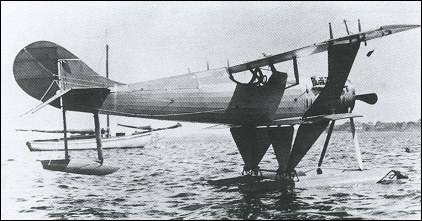|
| In the late autumn of 1916, the US Navy framed a requirement
which, issued on 17 November, called for a
float-equipped single-seat fighting scout with a max
speed of at least 153km/h and an endurance
of 2.5 hrs. It was envisaged that a 165hp Gnome Monosoupape
9N rotary engine would be used. To meet this
requirement, W Starling Burgess of the Burgess Company
of Marblehead, Mass, a division of the Curtiss
Aeroplane and Motor Corporation, produced the HT-B
which was demonstrated to the Navy Department on 19
May 1917. A fabric-covered wooden sesquiplane in
which close attention had been paid to aerodynamic
cleanliness, the HT-B had fabric-covered K-type interplane
struts, the short floats embodying shock absorbers.
The intended armament comprised a single 7.62mm machine gun, but the rotary engine being
unavailable, the HT-B was fitted with a water-cooled
Curtiss OXX-2 of 100hp. With this it was underpowered,
max attainable speed being 137km/h.
Nevertheless, the Navy considered the HT-B to possess
excellent aerodynamic and hydrodynamic qualities,
placing a contract for six examples (later amended to
include two additional aircraft). Known unofficially as
the Speed Scout, the first HT-B was delivered to Squantum
on 11 September 1917, and the second to Pensacola
in the following month, neither carrying armament.
These were followed by six more of a slightly modified
version known as the HT-2, all being delivered by the
end of 1917. No details of the subsequent career in US
Navy service of the HT-B are available, but this is
understood to have been brief and did not long survive
the demise of the Burgess Company in November 1918.
 | A three-view drawing (1660 x 1060) |
| DIMENSIONS |
| Wingspan | 10.46 m | 34 ft 4 in |
| Length | 6.87 m | 23 ft 6 in |
| Height | 3.28 m | 11 ft 9 in |
| PERFORMANCE |
| Max. speed | 137 km/h | 85 mph |
| Anonymous, 20.06.2022 15:22 Unlike most American airplanes of that time this was actually quite a modern design, and comparable to any of its' European contemporaries. However, it was let down by the lack of a suitable engine. By 1917, the 100-hp Curtiss water-cooled engine would clearly have been insufficient for any combat aircraft. However, if the 150-hp Hispano-Suiza V-8 engine, already which was already in production in France and was soon to be in production under license in the U.S., had been made available to Burgess, then the Navy might really have had something. reply | | Bill Deane, e-mail, 07.03.2016 19:06 On the topic of the Burgess Company at Marblehead ---The company built exceptional aircraft for private and military use.The Burgess Company had excellent reviews by the Army and Navy and had no problem getting government orders during WWI. On the issue of the fire which consumed the factory on Marblehead Harbor the fire was caused by spontanous combustion of coal which was stored under and along side the two factory buildings located along the harborside. The fire and the war's end resulted in the closure of the aircraft and other factory operations by 1919. Marblehead Historical Society and the Marblehead Historical Commission have excellent photo collections and exhibits on the saga of the Burgess Company of Marblehead. reply | | John Magnuson, e-mail, 17.04.2014 02:00 Being a former AF Sgt. and F86D crew chief and a holder of a student pilots license I,m very interested in all airplanes. His plane with the rear float is the first plane I have seen with a rear float. Thanks for the good web site. John reply | | Bill Deane, e-mail, 24.11.2013 22:00 Re: The Burgess Co.Fire; the original Burgess aircraft Plant #1 was on Redstone Lane in Marblehead, MA, it was a cluster of wooden structures that were originally boat building shops. The Curtiss Co. when they bought the Burgess Co. built Plant #2 consisting of two new steel and metal sided assembly plants 1 /4 mile north of the older site. On November 7, 1918 those new buildings caught fire and the aircraft under construction, the parts and the assembly lines were totally destroyed as a result of spontaneous combustion in the coal used to heat and power the plant. A comprehensive U.S.Navy investigation later in late November and in December confirmed that cause of the fire was the in the spontaneous combustion of the coal stored under and around the assembly buildings. A copy of that Navy report is available in National Archives in Washington DC. reply | |
| | Dennis Eggert, e-mail, 14.09.2012 21:07 We have original floats for a 1911 Steco Aerohydroplane that were built by Burgess. Airctraft was designed and built by James S. Stephens who lived in the Chicago area just after the turn of the cetury. The aircraft was recovered in 1990 found in a garage in Maywood, IL. It's a one of-a-kind airctaft that was stored in 1914 at the out break of WW I. It's now in St. Paul, MN in storage. September 14, 2012. reply | | Randy Bartlett, e-mail, 05.09.2010 22:10 Burgess built aircraft for the USN & USMC during WWI. By some strange "coincidence", the Burgess plant, in Marblehead, Ma. burned to the ground on 10 Nov. 1918. reply |
|
Do you have any comments?
|
| 
All the World's Rotorcraft |






